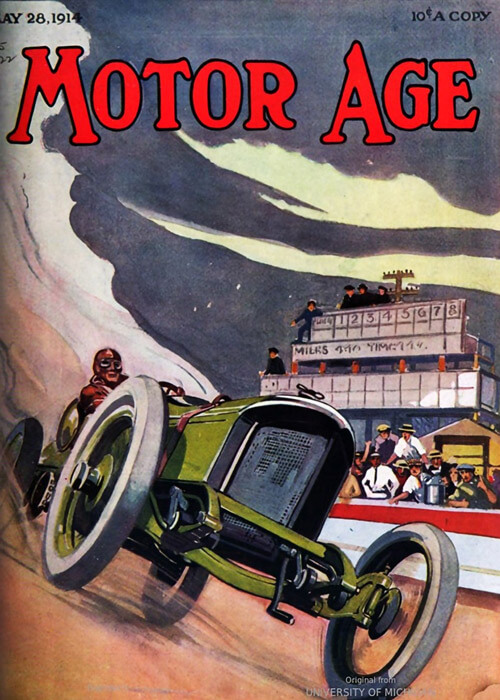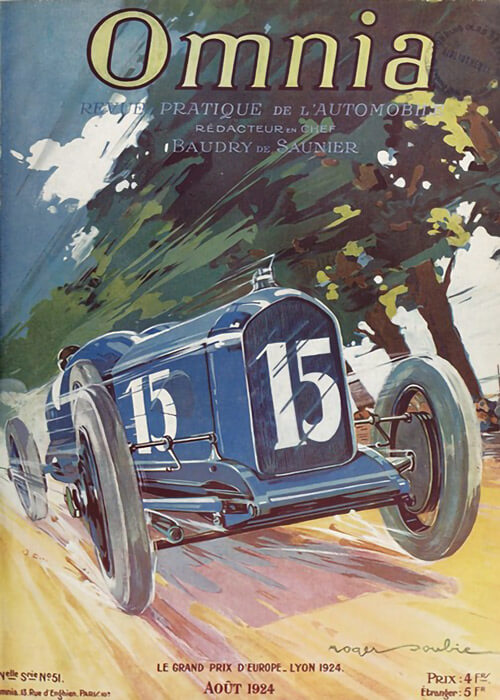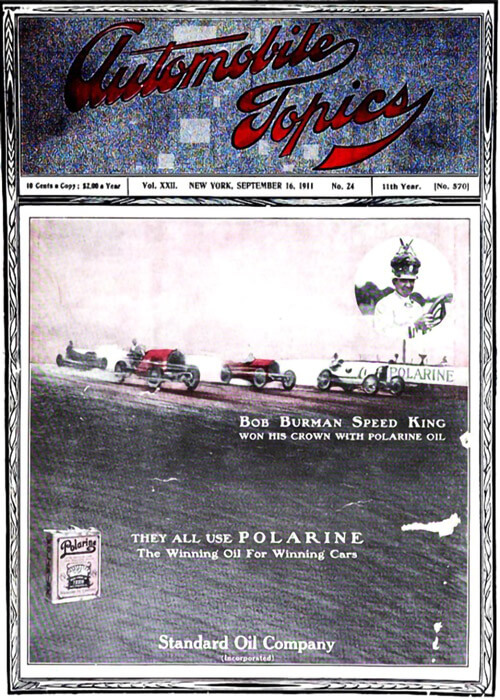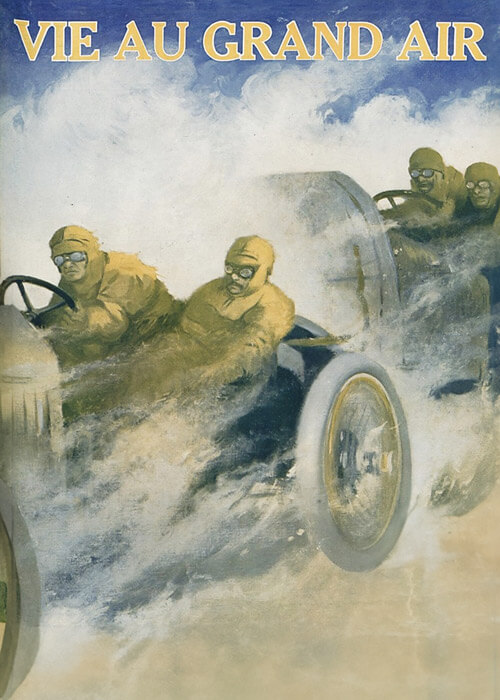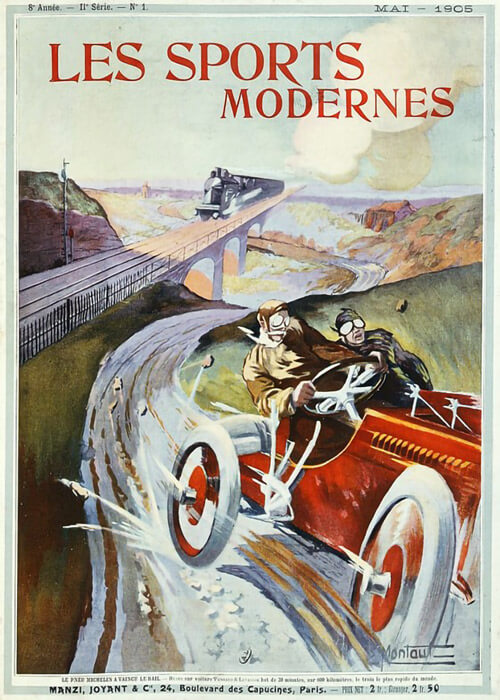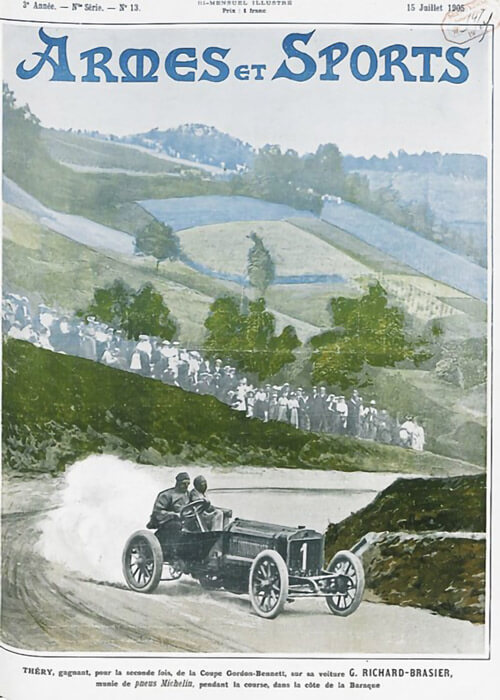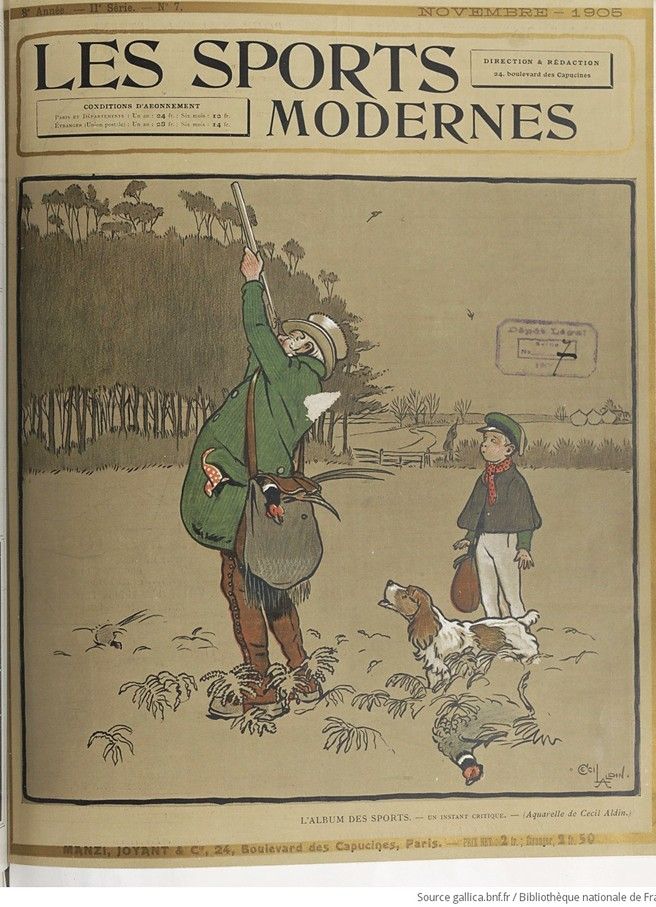
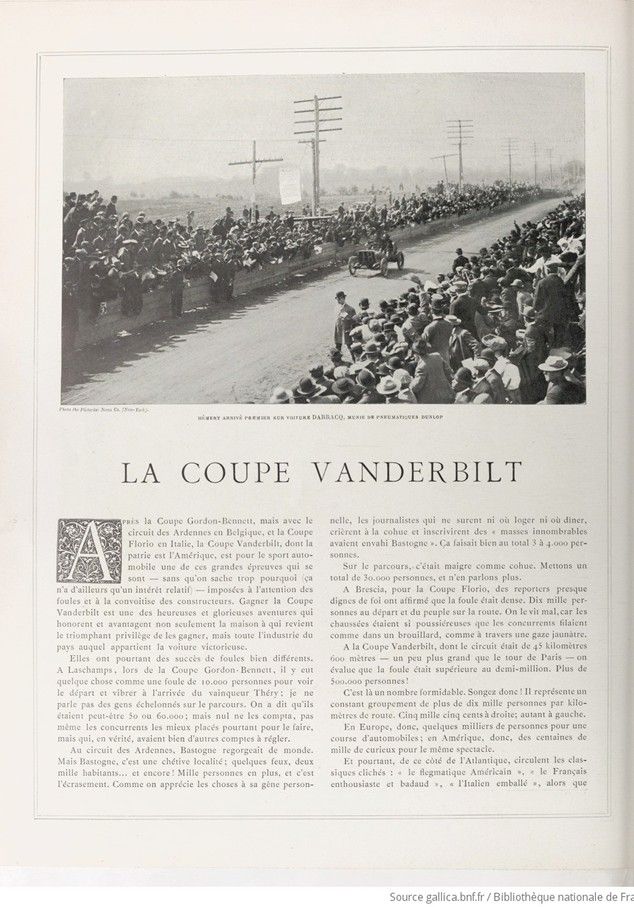
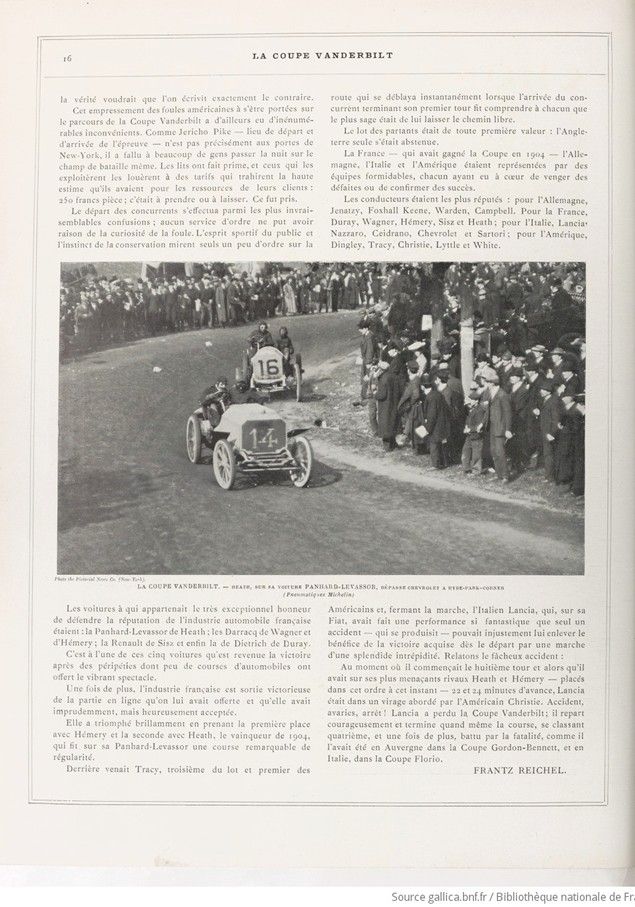
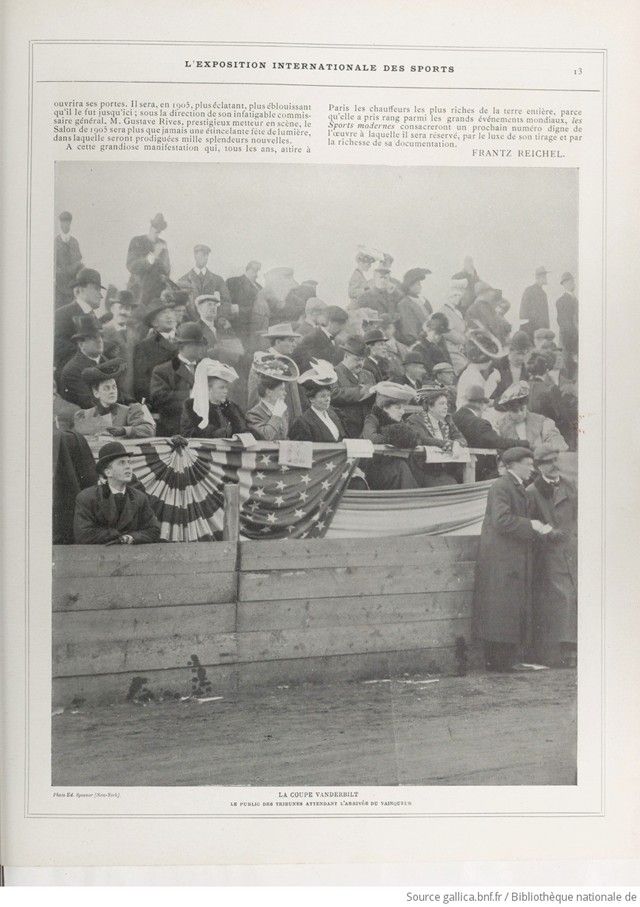
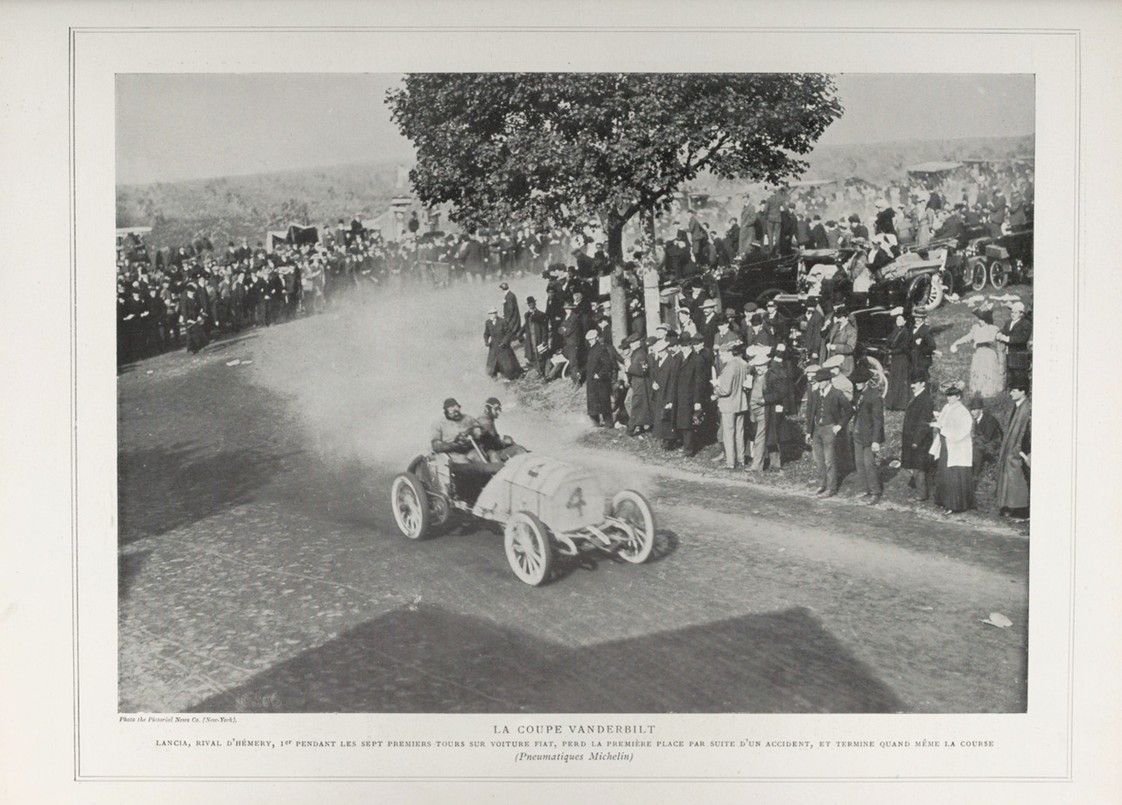
Texte et photos avec l’autorisation du Bibliothèque nationale de France- gallica.bnf.fr https://www.bnf.fr/fr
Les Sports Modernes, 8e Année, IIe Serie, No. 7, Novembre 1905
LA COUPE VANDERBILT 1905
APRÈS la Coupe Gordon-Bennett, mais avec le circuit des Ardennes en Belgique, et la Coupe Florio en Italie, la Coupe Vanderbilt, dont la patrie est l’Amérique, est pour le sport automobile une de ces grandes épreuves qui se sont — sans qu’on sache trop pourquoi ça n’a d’ailleurs qu’un intérêt relatif) — imposées à l’attention des foules et à la convoitise des constructeurs. Gagner la Coupe Vanderbilt est une des heureuses et glorieuses aventures qui honorent et avantagent non seulement la maison à qui revient le triomphant privilège de les gagner, mais toute l’industrie du pays auquel appartient la voiture victorieuse.
Elles ont pourtant des succès de foules bien différents. A Laschamps, lors de la Coupe Gordon-Bennett, il y eut quelque chose comme une foule de 10.000 personnes pour voir le départ et vibrer à l’arrivée du vainqueur Théry ; je ne parle pas des gens échelonnés sur le parcours. On a dit qu’ils étaient peut-être 5o ou 60.000; mais nul ne les compta, pas même les concurrents les mieux placés pourtant pour le faire, mais qui, en vérité, avaient bien d’autres comptes à régler.
Au circuit des Ardennes, Bastogne regorgeait de monde. Mais Bastogne, c’est une chétive localité ; quelques feux, deux mille habitants… et encore ! Mille personnes en plus, et c’est l’écrasement. Comme on apprécie les choses à sa gêne personnelle, les journalistes qui ne surent ni où loger ni où dîner, crièrent à la cohue et inscrivirent des « masses innombrables avaient envahi Bastogne ». Ça faisait bien au total 3 à 4.000 personnes.
Sur le parcours, c’était maigre comme cohue. Mettons un total de 3o.ooo personnes, et n’en parlons plus.
A Brescia, pour la Coupe Florio, des reporters presque dignes de foi ont affirmé que la foule était dense. Dix mille personnes au départ et du peuple sur la route. On le vit mal, car les chaussées étaient si poussiéreuses que les concurrents filaient comme dans un brouillard, comme à travers une gaze jaunâtre.
A la Coupe Vanderbilt, dont le circuit était de 45 kilomètres 600 mètres — un peu plus grand que le tour de Paris — on évalue que la foule était supérieure au demi-million. Plus de 500.000 personnes!
C’est là un nombre formidable. Songez donc ! Il représente un constant groupement de plus de dix mille personnes par kilomètres de route. Cinq mille cinq cents à droite ; autant à gauche.
En Europe, donc, quelques milliers de personnes pour une course d’automobiles; en Amérique, donc, des centaines de mille de curieux pour le même spectacle.
Et pourtant, de ce côté de l’Atlantique, circulent les classiques clichés : « le flegmatique Américain. », « le Français enthousiaste et badaud », « l’Italien emballé », alors que la vérité voudrait que l’on écrivît exactement le contraire.
Cet empressement des foules américaines à s’être portées sur le parcours de la Coupe Vanderbilt a d’ailleurs eu d innumérables inconvénients. Comme Jéricho Pike — lieu de départ et d’arrivée de l’épreuve — n’est pas précisément aux portes de New-York, il a fallu a beaucoup de gens passer la nuit sur le champ de bataille même. Les lits ont fait prime, et ceux qui les exploitèrent les louèrent à des tarifs qui trahirent la haute estime qu’ils avaient pour les ressources de leurs clients : 250 francs pièce ; c’était à prendre ou à laisser. Ce fut pris.
Le départ des concurrents s’effectua parmi les plus invraisemblables confusions ; aucun service d’ordre ne put avoir raison de la curiosité de la foule. L’esprit sportif du public et l’instinct de la conservation mirent seuls un peu d’ordre sur la route qui se déblaya instantanément lorsque l’arrivée du concurrent terminant son premier tour fit comprendre à chacun que le plus sage était de lui laisser le chemin libre.
Le lot des partants était de toute première valeur : l’Angleterre seule s’était abstenue.
La France — qui avait gagné la Coupe en 1904 — l’Allemagne, l’Italie et l’Amérique étaient représentées par des équipes formidables, chacun ayant eu à cœur de venger des défaites ou de confirmer des succès.
Les conducteurs étaient les plus réputés : pour l’Allemagne, Jenatzy, Foxhall Keene, Warden, Campbell. Pour la France, Duray, Wagner, Hémery, Sisz et Heath; pour l’Italie, Lancia, Nazzaro, Ceidrano, Chevrolet et Sartori ; pour l’Amérique, Dingley, Tracy, Christie, Lyttle et White.
Les voitures à qui appartenait le très exceptionnel honneur de défendre la réputation de l’industrie automobile française étaient : la Panhard-Levassor de Heath ; les Darracq de Wagner et d’Hémery ; la Renault de Sisz et enfin la de Dietrich de Duray.
C’est à l’une de ces cinq voitures qu’est revenue la victoire après des péripéties dont peu de courses d’automobiles ont offert le vibrant spectacle.
Une fois de plus, l’industrie française est sortie victorieuse de la partie en ligne qu’on lui avait offerte et qu’elle avait imprudemment, mais heureusement acceptée.
Elle a triomphé brillamment en prenant la première place avec Hémery et la seconde avec Heath, le vainqueur de 1904, qui fit sur sa Panhard-Levassor une course remarquable de régularité.
Derrière venait Tracy, troisième du lot et premier des Américains et, fermant la marche, l’Italien Lancia, qui, sur sa Fiat, avait fait une performance si fantastique que seul un accident — qui se produisit — pouvait injustement lui enlever le bénéfice de la victoire acquise dès le départ par une marche d’une splendide intrépidité. Relatons le fâcheux accident :
Au moment où il commençait le huitième tour et alors qu’il avait sur ses plus menaçants rivaux Heath et Hémery — placés dans cet ordre à cet instant — 22 et 24 minutes d’avance, Lancia était dans un virage abordé par l’Américain Christie. Accident, avaries, arrêt ! Lancia a perdu la. Coupe Vanderbilt ; il repart courageusement et termine quand même la course, se classant quatrième, et une fois de plus, battu par la fatalité, comme il l’avait été en Auvergne dans la Coupe Gordon-Bennett, et en Italie, dans la Coupe Florio. FRANTZ REICHEL.
Images d’article
LA COUPE VANDERBILTLE PUBLIC DES TRIBUNES ATTENDANT L’ARRIVÉE DU VAINQUEUR – (Photo the Pictorial News Co. (New York)
HÉMERY ARRIVÉ PREMIER SUR VOITURE DARRACQ, MUNIE DE PNEUMATIQUES DUNLOP – (Photo the Pictorial News Co. (New York)
LANCIA, RIVAL D’HÉMERY, 1er PENDANT LES SEPT PREMIERS TOURS SUR VOITURE FIAT, PERD LA PREMIÈRE PLACE PAR SUITE D’UN ACCIDENT, ET TERMINE QUAND MEME LA COURSE (Pneumatiques Michelin) – (Photo the Pictorial News Co. (New York)


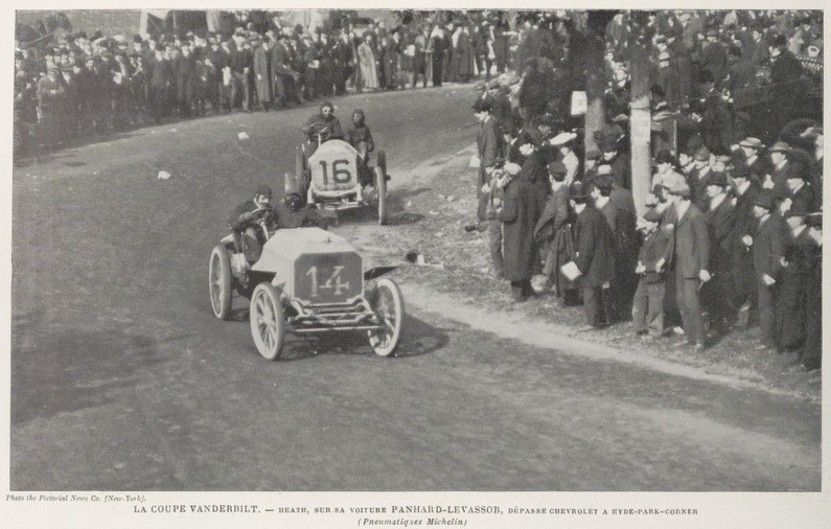

Translation by motorracinghistory.com, supported by DeepL.com
Les Sports Modernes 8th Year, IIe Serie, No. 7, November 1905
THE VANDERBILT CUP
AFTER the Gordon Bennett Cup, but with the Ardennes circuit in Belgium, and the Florio Cup in Italy, the Vanderbilt Cup, whose homeland is America, is one of those great events in motor sport that have – for reasons that are not really clear (and for that matter are of only relative interest) – attracted the attention of the crowds and the envy of the manufacturers. Winning the Vanderbilt Cup is one of the happy and glorious adventures that honor and benefit not only the house to which the triumphant privilege of winning them belongs, but the entire industry of the country to which the victorious car belongs.
However, they have very different crowd successes.
In Laschamps, during the Gordon-Bennett Cup, there was something like a crowd of 10,000 people to see the start and cheer on the arrival of the winner Théry; I’m not talking about the people spread out along the course. It was said that there were perhaps 50 or 60,000; but no one counted them, not even the competitors who were best placed to do so, but who, in truth, had many other scores to settle.
At the Ardennes circuit, Bastogne was overflowing with people.
But Bastogne is a small town; a few houses, two thousand inhabitants… and even that’s pushing it! A thousand more people, and it would have been overcrowded. As we appreciate things from our own personal discomfort, the journalists, who didn’t know where to stay or eat, cried out that it was a crowd and wrote that “innumerable masses had invaded Bastogne”. That made a grand total of 3 to 4,000 people.
On the course, it was a poor crowd. Let’s put the total at 30,000 people, and say no more about it.
In Brescia, for the Florio Cup, almost reliable reporters claimed that the crowd was dense. Ten thousand people at the start and people on the road. It was difficult to see, because the roads were so dusty that the competitors sped by as if in a fog, as if through a yellowish gauze.
At the Vanderbilt Cup, whose circuit was 45 kilometers 600 meters – a little bigger than the tour of Paris – it is estimated that the crowd was over half a million. More than 500,000 people!
That is a huge number. Just think about it! It represents a constant grouping of more than ten thousand people per kilometer of road. Five thousand five hundred on the right; the same on the left.
In Europe, therefore, a few thousand people for a car race; in America, therefore, hundreds of thousands of onlookers for the same spectacle.
And yet, on this side of the Atlantic, the classic clichés circulate: “the phlegmatic American”, “the enthusiastic and curious Frenchman”, “the excited Italian”, when the truth would have us write exactly the opposite.
This eagerness of the American crowds to flock to the Vanderbilt Cup course also had countless disadvantages. As Jericho Pike – the start and finish point of the event – is not exactly on the doorstep of New York, many people had to spend the night on the battlefield.The beds were at a premium, and those who exploited them rented them at rates that betrayed the high esteem in which they held their customers‘ resources:
250 francs each; it was take it or leave it. It was taken.
The competitors set off amid the most incredible confusion; no security service could overcome the curiosity of the crowd. The sporting spirit of the public and the instinct for conservation alone brought some order to the road, which cleared instantly when the arrival of the competitor finishing his first lap made everyone understand that it was wisest to leave him the road clear.
The starting field was of the highest caliber: only England had abstained.
France – which had won the Cup in 1904 – Germany, Italy and America were represented by formidable teams, each eager to avenge defeats or confirm successes.
The drivers were the most renowned: for Germany, Jenatzy, Foxhall Keene, Warden, Campbell. For France, Duray, Wagner, Hémery, Sisz and Heath; for Italy, Lancia, Nazzaro, Ceidrano, Chevrolet and Sartori; for America, Dingley, Tracy, Christie, Lyttle and White.
The cars that had the very exceptional honor of defending the reputation of the French automobile industry were: the Panhard-Levassor of Heath; the Darracqs of Wagner and Hémery; the Renault of Sisz and finally the de Dietrich of Duray.
One of these five cars was victorious after a series of events that few car races have offered such a stirring spectacle.
Once again, French industry emerged victorious from the race that had been offered to it and which it had recklessly but fortunately accepted.
It triumphed brilliantly, taking first place with Hémery and second with Heath, the 1904 winner, who drove his Panhard-Levassor to a remarkable regularity race.
Tracy came in behind, third in the lot and first of the Americans, and bringing up the rear was the Italian Lancia, who had put in such a fantastic performance in his Fiat that only an accident – which happened – could unfairly take away the benefit of the victory gained from the start by a driver of splendid intrepidity. Let us relate the unfortunate accident:
As he was starting the eighth lap and with a 22- and 24-minute lead over his most dangerous rivals Heath and Hémery, who were in that order at that moment, Lancia was in a corner being approached by the American Christie. Accident, damage, stop! Lancia lost the Vanderbilt Cup; he set off again courageously and finished the race all the same, coming fourth, and once more, defeated by fate, as he had been in Auvergne in the Gordon-Bennett Cup, and in Italy, in the Florio Cup. FRANTZ REICHEL.
Picture captions.
THE VANDERBILT CUP
THE AUDIENCE IN THE STANDS WAITING FOR THE ARRIVAL OF THE WINNER – (Photo the Pictorial News Co. (New York)
HÉMERY ARRIVED FIRST IN A DARRACQ CAR, EQUIPPED WITH DUNLOP TIRES – (Photo the Pictorial News Co. (New York)
LANCIA, HÉMERY’S RIVAL, IN THE LEAD FOR THE FIRST SEVEN LAPS IN A FIAT CAR, LOSES FIRST PLACE AFTER AN ACCIDENT, AND EVEN FINISHES THE RACE (Michelin tires) – (Photo the Pictorial News Co. (New York)
THE VANDERBILT CUP. — HEATH, IN HIS PANHARD-LEVASSOR CAR, PASSES CHEYROLET AT HYDE-PARK-CORNER (Michelin tires) – (Photo the Pictorial News Co. (New York)
